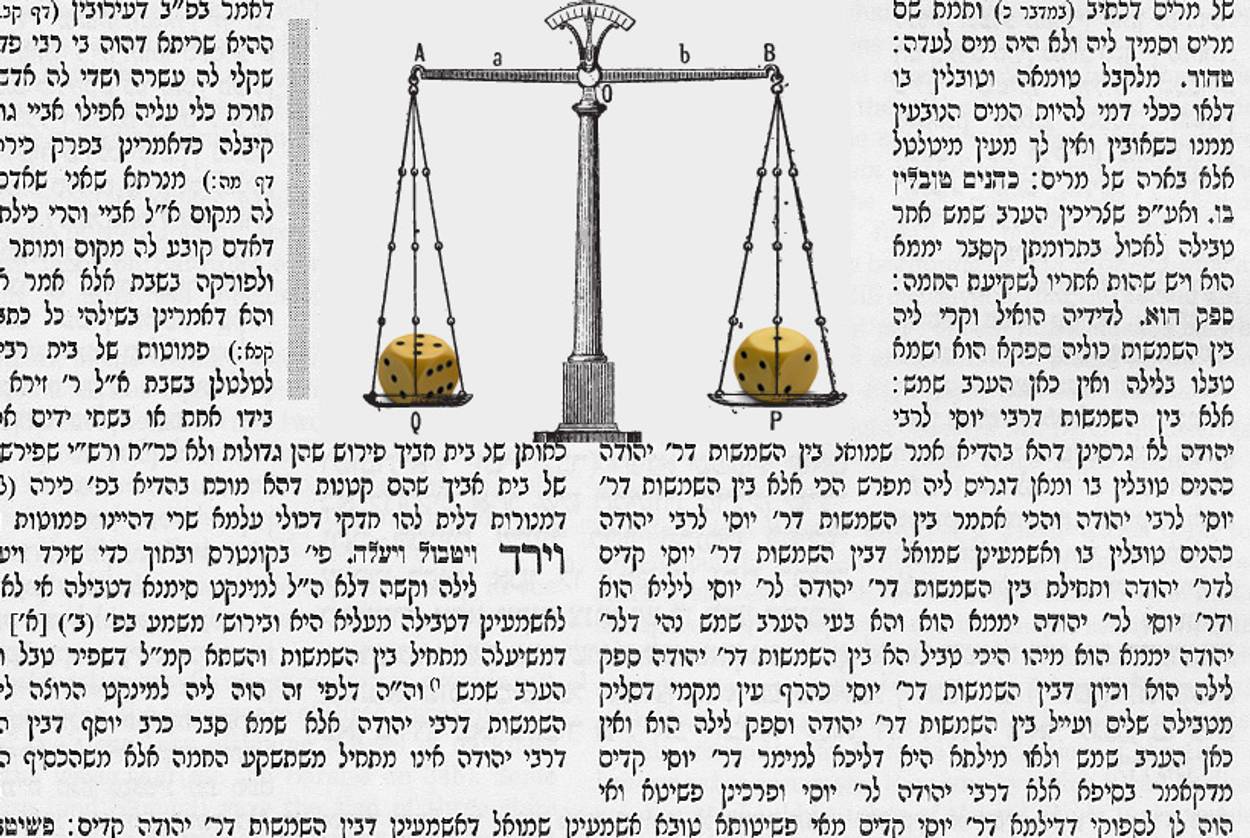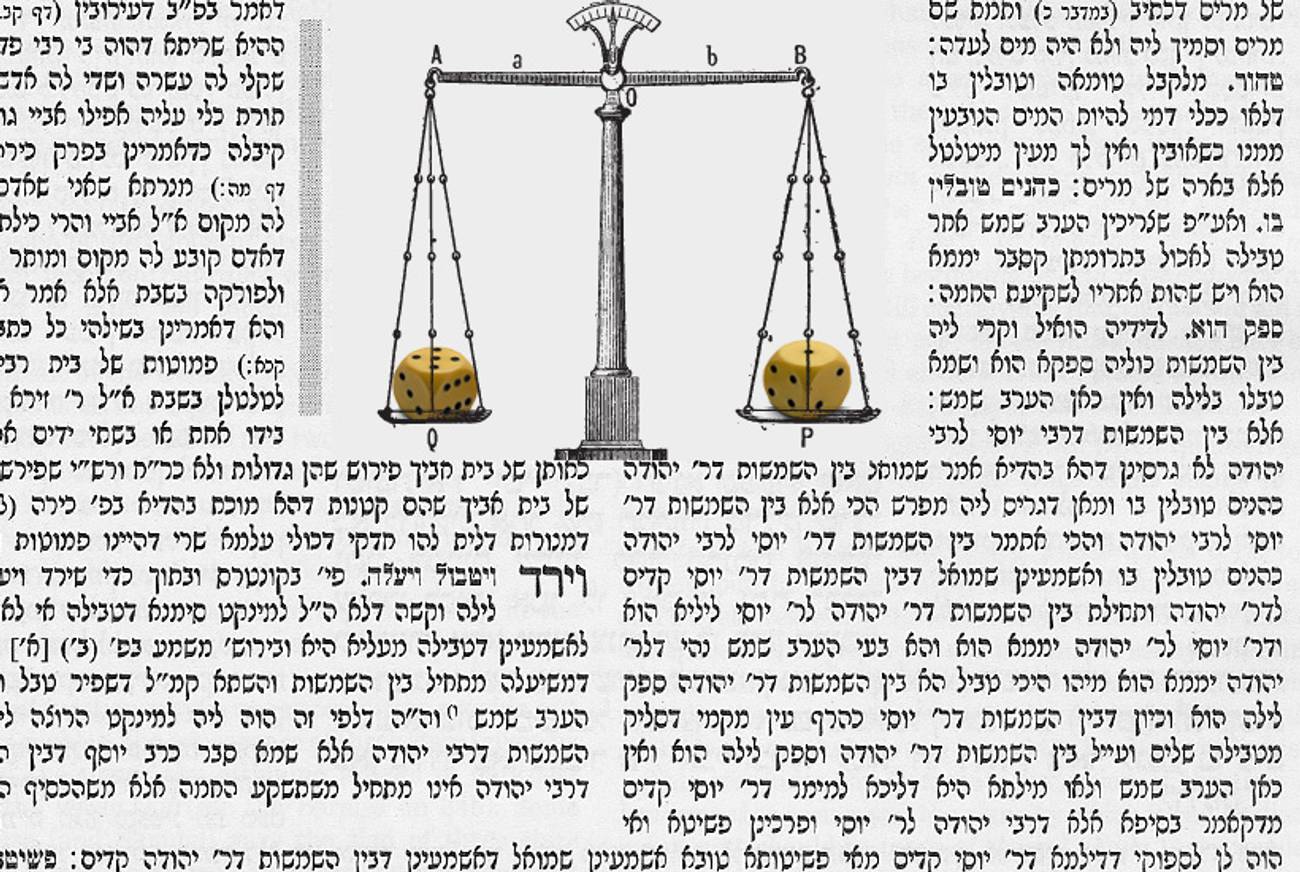Math Lessons and Quantum Physics in Studies of Rabbinic Stringency and Leniency
Daf Yomi: For generations, Talmudic training has meant exercising the mind in logical thinking, not just learning laws




Literary critic Adam Kirsch is reading a page of Talmud a day, along with Jews around the world.
When the Daf Yomi reading for last week ended, we left the rabbis in the middle of a discussion of weasels and chametz that was really a debate about probability. On the day before Passover, we learned at the beginning of Tractate Pesachim, a house must be searched for chametz, and all that’s found must be destroyed. What happens, though, if you get rid of all your chametz and then a weasel drags some new chametz into your house? Do you have to do a new search, or can you assume that the weasel either ate the chametz or dragged it back out again?
In this week’s Talmud reading, the discussion continued with a new series of hypotheticals involving mice, each of which posed a different kind of question about probability. Say, for instance, that you had nine piles of matzo and one pile of chametz, and a mouse came and took a piece from one of the piles and carried it into a house. How do we calculate the odds that the food the mouse picked up was chametz, which would then require the house to be searched again? On the face of it, this looks like an easy problem. Obviously, we might say, there is a 10 percent chance that the mouse took chametz, and a ninety percent chance that it took matzo.
That may be the right answer in a math class; but in Jewish law, we learn, things are not so simple. The rabbis argue the case by invoking an analogous problem from another area of law. Say that there are nine butchers selling kosher meat and one butcher selling unkosher meat. If a man buys meat from one of the 10 stores and then can’t remember which one he patronized, does he assume that the meat he has is kosher or unkosher? This is, clearly, the same mathematical problem as the one involving the mouse and the matzo.
Since the meat seemingly has a 90 percent chance of being kosher, one might assume that the rabbis would rule it permitted to eat. But, we learn in Pesachim 9b, that is not the way probability is calculated in this case. Instead of counting the number of stores, the rabbis insist that we count the number of possibilities, of which there are two—kosher and non-kosher. This means that there is only a 50-50 chance that the meat is kosher, rather than a 90 percent chance; and so it is ruled forbidden to eat. The same reasoning applies to the mouse: Since we don’t know which pile he took from, we must assume that he could equally well have taken from the matzo or the chametz. As a result, the house he enters must be searched again.
This way of calculating only applies, however, if the item in question was found “in its place.” If the meat was found in a butcher shop, and there were two kinds of butcher shops—kosher and non-kosher—then it has a 50-50 chance of coming from each kind. If, however, the meat was found on the ground, at random, then we can calculate the probability the usual way: In that case, there is a 90 percent chance it came originally from a kosher butcher, and so it can be eaten. Likewise, if the mouse took a bit of food from the floor, and we don’t know which pile it originally came from, then we decide there was a 90 percent chance it took matzo, and the house he enters does not have to be searched again.
Mathematically speaking, the rule known as “whatever is fixed [in its place] is treated as 50-50” does not seem to make any sense. It can be justified only as a precautionary measure, one of the frequent cases in which the rabbis “build a fence around the Torah” by being especially stringent. By changing the calculus about whether an item is kosher or un-kosher, matzo or chametz, the rule forces us to be extra cautious and so prevents us from making an accidental mistake.
But this is just the first of the problems the Talmud has in store. In the next hypothetical, the rabbis ask us to imagine a case in which there are two piles, one of matzo and one of chametz, and two houses, one of which has already been searched for chametz, while the other one has not. Now a mouse comes, takes food from one of the piles, and enters one of the houses, but we do not know for sure which pile or which house. This is another problem in probability, but in this case the law seems to operate with a different bias than before. Instead of being extra-stringent, in this case we are allowed to be extra-lenient: We assume that if the mouse took chametz, he brought it into the house that has not already been searched. In this way, we are spared the necessity of searching the clean house again. (Exactly why the rabbis are stringent in one case and lenient in another was not clear to me; indeed, the Schottenstein Edition’s notes say that this point has troubled some Talmudic commentators.)
Tractate Pesachim continues to offer other variations on this theme. What if a mouse carried some chametz into one of two houses, each of which was already cleansed, only we weren’t sure which of the two houses it entered? Would both houses have to be searched again, since each bears a 50-50 chance of having been contaminated?
The answer this time depends on what looks very much like a logical sleight of hand. If the owner of each house comes to a rabbi separately and asks if he must search his house again, the rabbi can tell each of them “No.” That is because, individually, each one has only a 1-in-2 chance of being contaminated, even though logically, one of the two must have been. But if both men come together to ask for advice, the rabbi can’t avoid the conclusion that at least one of the houses was contaminated, and so he must tell both men to search again.
This example reminded me very much of the problem in modern physics known as “Schrodinger’s Cat.” In this scenario, invented by the Austrian physicist Erwin Schrodinger in the 1930s, a cat is locked in a box with a decaying radioactive element and a bottle of cyanide. The box is constructed so that, when the element decays and emits a particle, the bottle is shattered and the cat dies. The problem is that, as long as the box remains closed, the laws of quantum physics make it impossible to say for sure whether or not a particle has been emitted. As a result, the cat can be said to be both alive and dead at the same time.
For Schrodinger, the thought experiment about the cat was a way of criticizing the indeterminacy of quantum physics. But the thought experiment of the rabbis seems to illustrate the same point, 1,500 years earlier. Each of the two householders represents one logical possibility—one has to have a contaminated house, and one has to have an uncontaminated house. As long as you consider them separately, however, it’s possible to say that both houses are clean. It’s only once the two men come together—or, in Schrodinger’s example, once the lid of the box is removed—that this indeterminacy collapses.
The comparison of the Talmud with quantum physics may sound far-fetched, but the truth is that this whole stretch of Tractate Pesachim could be put directly into a math textbook. It is a reminder that Talmudic training, for many generations of Jewish students, was a way of training the mind in logical thinking as well as learning a body of laws.
And about those laws. Those reading Daf Yomi will have noticed that the subjects I discussed in this column only take up the first page or two of the past week’s reading. That is because, starting with Pesachim 14a and continuing until the end of Chapter 1, the rabbis switch over to an entirely different, and extremely challenging, subject: the laws of ritual purity and impurity, taharah and tumah. Next week, after taking a deep breath, I will plunge into those murky waters.
***
Like this article? Sign up for our Daily Digest to get Tablet Magazine’s new content in your inbox each morning.
Adam Kirsch is a poet and literary critic, whose books include The People and the Books: 18 Classics of Jewish Literature.
Adam Kirsch is a poet and literary critic, whose books include The People and the Books: 18 Classics of Jewish Literature.